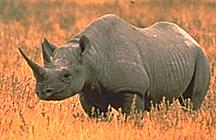Rhinoceroses
|
|
- For other uses of the term see Rhinoceros (disambiguation).
| Rhinoceroses | ||||||||||
|---|---|---|---|---|---|---|---|---|---|---|
 | ||||||||||
| Scientific classification | ||||||||||
| ||||||||||
| Species | ||||||||||
|
Ceratotherium simum |
A rhinoceros (commonly called a rhino for short) is any of five surviving species of odd-toed ungulate in the family Rhinocerotidae. All five are native to Africa or Asia. Rhinoceros is also one of the genera in this family.
Order Perissodactyla
- Family Equidae: horses and allies
- Family Tapiridae: tapirs, 4 species in one genus
- Family Rhinocerotidae
- Ceratotherium
- C. simum - White Rhinoceros
- Dicerorhinus
- D. sumatrensis - Sumatran Rhinoceros
- Diceros
- D. bicornis - Black Rhinoceros
- Rhinoceros
- R. unicornis - Indian Rhinoceros
- R. sondaicus - Javan Rhinoceros
- Coelodonta
- C. antiquitatis - Woolly Rhinoceros (extinct)
- Ceratotherium
Several other species became extinct within geologically recent times, notably the Giant Unicorn and the Woolly Rhinoceros in Eurasia: the extent to which climate change or human predation was responsible is debated. Suffice to say that they had survived many climate changes when modern man arrived.
Rhinoceros-like animals first appeared in the Eocene as rather slender animals, and by the late Miocene there were many different species. Most were large. One, Indricotherium weighed about 30 tons and (so far as is known) was the largest terrestrial mammal that ever lived. Rhinos became extinct during the Pliocene in North America, and during the Pleistocene in northern Asia and Europe.
Brhino8F.jpg
The five living species fall into three tribes. The critically endangered Sumatran Rhinoceros is the only surviving representative of the most primitive group, the Dicerorhinini, which emerged in the Miocene (abut 20 million years ago). There are two living Rhinocerotini species, the endangered Indian Rhinoceros and the critically endangered Javan Rhinoceros, which diverged from one another about 10 million years go. The extinct Wooly Rhinoceros of northern Europe and Asia was also a member of this tribe. The two African species, the White Rhinoceros and the Black Rhinoceros, diverged during the early Pliocene (about 5 million years ago) but the Dicerotini group to which they belong originated in the middle Miocene, about 14 million years ago. The main differance between black and white rinos is the shape of their lips. White rinos have broad flat lips for grazing and black rinos have long pointed lips for eating foliage, The name White Rhinoceros was actually a mistake for wide because of their lips.
Rhinoceros horns are used in traditional Asian medicine, and for dagger handles in Yemen and Oman. None of the five rhinoceros species have secure futures: the White Rhino is perhaps the least endangered, the Javanese Rhino survives in only tiny numbers (estimated at 60 animals in 2002) and is one of the two or three most endangered large mammals anywhere in the world.
Rhino protection campaigns began in the 1970s, but rhino populations have continued to decline dramatically. Trade in rhinoceros parts is forbidden under the CITES agreements, but poaching is a severe threat to all rhinoceros species.
The most obvious distinguishing characteric of the rhinos is a large horn on the nose. The word rhinoceros comes from the Greek words rhino (nose) and keros (horn). Rhinoceros horns, unlike those of other horned mammals, consist of keratin, densely compacted hair.
African cookery
The legs and feet of the rhinoceros are cooked in the following fashion by certain tribes in the south of Africa: First, one would find an ant nests, composed of hard clay and shaped roughly like a baker's oven, ranging from two to four feet in height. Then, one would hollow them out, removing the ants in the process. The space thus obtained is filled with burning wood, till the bottom and sides become red hot within. The embers of the wood are then removed, the leg or foot of the rhinoceros introduced, and a door closed up with heated clay and embers. Fire is then also made on the outside, covering the nest, and the meat is left to cook for several hours. This dish is considered a delicacy by many of the native tribes.
Nature's Firefighter
There are a number of legends about the rhinoceros stamping out fire. The story seems to have been common in Malaysia and Burma.
This type of rhinoceros even had a special name in Malay, 'badak api', where badak means rhinoceros and api means fire. The animal would come when a fire is lit in the forest and stamp it out.
Whether or not there is any truth to this has not yet been proven. Suffice it to say that there has been no sighting of this phenomenon in recent history, something which may stem from the fact that rhinoceros sightings overall in South East Asia have become very rare - much due to widespread illegal poaching of the critically endangered animal.
References
- Chapman, Jan. 1999. The Art of Rhinoceros Horn Carving in China. Christies Books, London. ISBN: 0903432579.
- Laufer, Berthold. 1914. "History of the Rhinoceros." In: Chinese Clay Figures, Part I: Prolegomena on the History of Defence Armor. Field Museum of Natural History, Chicago, pp. 73-173.
